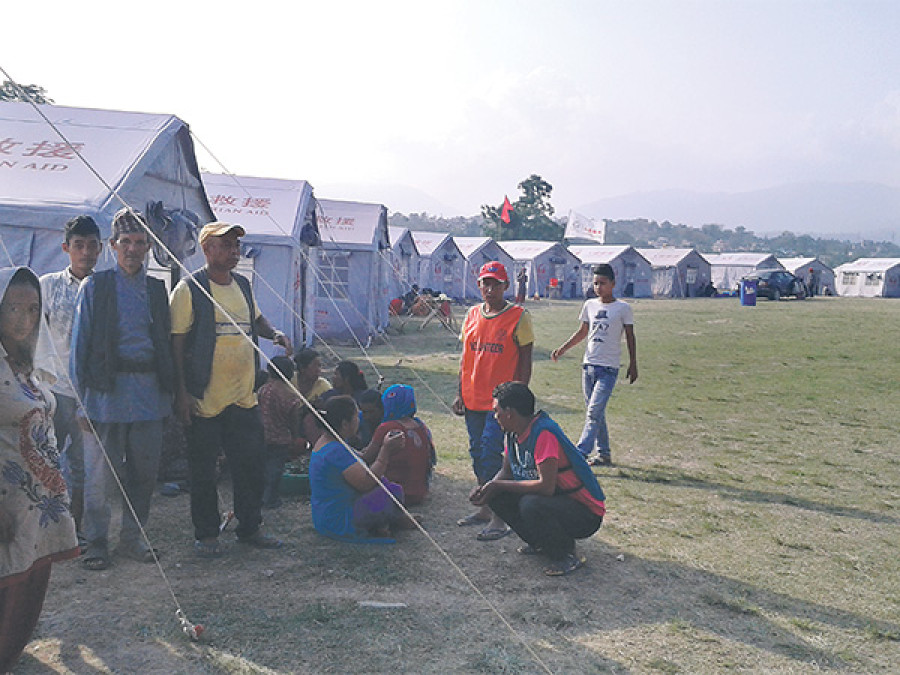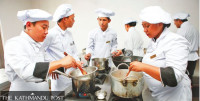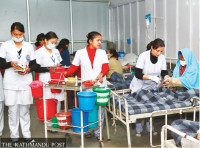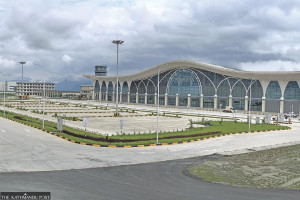Miscellaneous
Displaced swarm into Valley
Binod Thapa had a dream since childhood. A dream of living in a cemented house. After a decade of tireless efforts, Thapa and his extended family had saved enough to build a house.
Roshan Sedhai & Rishi Ram Poudel
They had been planning to shift to a new house by the end of this month. But it was not to be. The Great Earthquake of April 25 changed everything. The house was literally swept away by a landslide that followed the quake, reducing Thapa’s lifelong savings into ruins within seconds.
Thapa and the eleven members of his family are now taking refuge at a makeshift tent in Bode of Bhaktapur. Dugunagadhi-7 of Sindhupalchok, where Thapa was born, raised and lived until last month, is deserted now. The village lies buried in stones and mud, open spaces have sustained severe cracks and water sprouts have vanished. Having lost everything and a bleak prospect of survival in front of them, Thapas had no choice but to flee the village in desperation to save their lives.
The Thapas are among nearly 16,000 people who have left Sindhupalchok in the quake aftermath, according to the estimates of local authorities. A majority of them have come to the Capital and started living en masse in tents.
Increasing numbers of people are now coming to Kathmandu from other districts including Nuwakot, Dhading and Kavrepalanchok.
Sindhupalchok is one of the worst affected districts by the quake with a heavy loss of life, shelter and livestock. The District Natural Disaster Rescue Committee, Sindhupalchok has declared over two dozen village development committees as high-risk geo-hazard areas. Villages in western areas of the districts including Baruwa, Bhotang, Thangpalkot, Gunsa, Haibung and Mahankal have been left uninhabitable.
“We still don’t know exactly how many people have left the village, but most areas already look deserted,” said CDO Krishna Prasad Gyawali.
Nepal Army Major Prem Malla of the Bhimkali Battalion said some people from remote areas are still in the village though most of the VDCs look almost deserted. “Dozens of busloads of desperate villagers are leaving every day,” said Malla.
The Bode camp where Thapas are living is home to around 1,500 people fleeing various villages of Sindhupalchok. There are around 198 tents provided by the Chinese government.
Thousands more are living in similar camps in different places across the Valley, including Bouddha and Chabahil. Some others who can afford to pay are living in rented house or sharing shelter with their relatives living in the Capital.
Ashok Acharya, 37, said people started to leave the villages in desperation following the powerful aftershock of May 12. The villagers had already arranged a makeshift shelter in lower plains of the district with locally available resources a few days after the first quake.”Things were returning to normal before the aftershocks shattered the very core of our souls,” said Acharya, who is also living in a temporary shelter at Bode.
Even after arriving in the Capital, they had to go through a series of hardships to find open spaces before finally settling in a privately owned land in Nilbarahi. They could not get open spaces in Kathmandu due to the resistance from the locals.
Quake victims complained of not getting enough attention from the government as they are surviving on scarce provisions from NGOs and good Samaritans. There is even bigger scarcity of toilet and drinking water. Security and safety, however, look sound thanks to constant vigilance of local clubs and security arrangement of the nearest police stations.
The displaced people know that they cannot occupy the private land forever. They want the government to relocate them to a safer location.
“The conditions are difficult for children and elderly.
The government should immediately show long-term alternatives for us,” said Acharya, adding that he is willing to shift into a rented house but he has not been able to find one.
Home Ministry spokesman Laxmi Prasad Dhakal say his ministry is aware of the movement of hordes of displaced people into the Capital. The government would soon find an alternative shelter for the genuinely displaced instead of allowing them to occupy public places, he said.
Those living in Bode said elderly, children and pregnant women are still living in the village because they could not be airlifted. “Most of them have moved to forest areas in the upper region in the district,” said Pasangbuti Tamang of Ghumsa.
Tamang’s husband and his parents are currently taking shelter in a jungle as they could not make it to the helicopter.
The Tamang family had to leave the area even without properly burying one of their relatives who died during the quake. Tamang and her five daughters were airlifted from her village and brought to Kathmandu a few days after the quake.
DSP Dipak Kharel of Sindhupalchok says more people like Tamang’s husband might leave the village with the onset of monsoon.
“The land is prone to landslides as there are big cracks everywhere. There are fears that rainfall might cause more damage,” said Kharel.
Tamang who arrived in the camp on Wednesday had to keep changing places as no one was ready to provide shelter to her and her children. She was chased by locals of Kathmandu when she, alongside a few others, tried to put up a tent in a public area.
“Some people are asking to leave this tent too. I don’t know where to go with my kids as I know no one here. I don’t even have any money,” said Tamang, who barely speaks Nepali.
Rehabilitate victims at the earliest: PM
While the displaced people from the quake-hit districts are pouring into Kathmandu, the government has directed the authorities to rehabilitate those taking refuge at various place in the Capital.
Prime Minister Sushil Koirala directed the authorities on Friday to make arrangements for the victims living in the Valley to settle in their respective districts at the earliest.
Koirala, during a meeting with line ministers and top bureaucrats, said the government should expedite efforts to rehabilitate people living in makeshift shelters in open spaces across the Valley before monsoon starts.
Chief Secretary Leela Mani Paudyal, however, said rehabilitation works will start only after geologists present a detailed damage assessment report of the affected districts. “We have assigned expert teams to identify safer places in the districts for resettlement,” he said.
Senior officials said their first priority will be to resettle the displaced in their own localities. They would be relocated to other districts only if safe places are not available in their district of residence. Also mooted is the option of relocating the displaced people to camps set up for former Maoist combatants in Chitwan and Jhapa districts if other possibilities are limited. (PR)




 12.12°C Kathmandu
12.12°C Kathmandu











